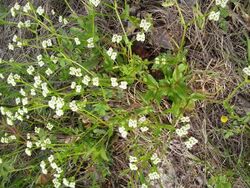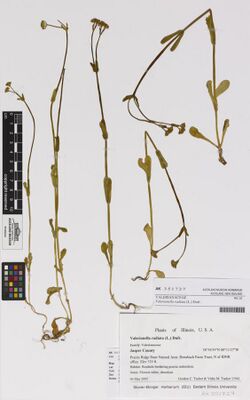Biology:Valerianella radiata
| Valerianella radiata | |
|---|---|

| |
| Scientific classification | |
| Kingdom: | Plantae |
| Clade: | Tracheophytes |
| Clade: | Angiosperms |
| Clade: | Eudicots |
| Clade: | Asterids |
| Order: | Dipsacales |
| Family: | Caprifoliaceae |
| Genus: | Valerianella |
| Species: | V. radiata
|
| Binomial name | |
| Valerianella radiata (L.) Dufr.
| |
Valerianella radiata, synonyms Valerianella stenocarpa and Valerianella woodsiana, common name beaked cornsalad, is a plant native to the United States.[1] It is an annual self pollinating flowering plant and besides being mildly edible there are no known uses.[2] Valerianella radiata flowers from April- May.[3]
Description
Valerianella radiata typically grows to a high of 0.6 m (2 ft).[2] Flowers are perfect.[3] Has 5 white flower petals that are arranged bilaterally symmetrical with fused sepals.[3] Simple, entire, and toothed[3] leaves with opposite arrangement of two leaves per node on stem.[4] It has a stamen count of three that produces dry fruit 2 - 2.5 mm long.[4] It has a pistil count of one with three carpels, inferiors ovary with 3 locales and one ovule, slightly 3-lobed stigmas.[3] Valerianella radiata has a corolla length of less than 2 mm.[5] The fruit is usually yellowish and glabrous to finely pubescent and the fertile cells are slightly narrower than sterile cells.[6] A groove forms between the narrow and fertile sides of the fruit.[6] It is a self-fertile plant due to having both male and female organs.[2] Stems are hollow and ascend to erect, dichotomously branching (an important diagnostic character), angled, and glabrous to sparse pubescence on stem wing margins.[3] Basal leaves are sessile, short-petiolate, spatulate, obovate with bases fused around the stem, glabrous along margins and midvein of the undersurface.[3] Inflorescences are clusters that are small, dense, and usually paired on branch tips that have lanceolate bracts to narrowly elliptic.[3]
Distribution and habitat
Valerianella radiata distribution is in deciduous forest regions of the eastern United States.[7] This species is commonly found in creek beds, roadsides, ditches, clearings, hilltops, and pasture lands.[7] Valerianella radiata can be found in areas ranging from moderate shade to full sunlight exposure.[5] Valerianella radiata may be present in Japan as an introduced plant. [8]
Conservation status
It is listed as a special concern and believed extirpated in Connecticut,[9] and listed as endangered in New Jersey. It is listed as a weed in other parts of the United States.[1]
Taxonomy
Valerianella radiata is an annual, meaning that it grows from a seed, produces seeds, and dies all within a growing season, leaving dormant seeds.[10] Valerianella radiata has funnelform flowers which commonly leads to inbreeding.[7] This species has two varieties: var. radiata and var. fernaldii[7]. Valerianella radiata was originally described by Linnaeus [7] but was later renamed by Dufresne, Pierre.[11]
Toxicity
This plant is not known to be toxic.[2]
Edibility
Young raw leaves and the roots of the plant are edible.[2] Roots of plant are an unlikely food source due to their minuscule size.[2]
Weed control
Valerianella radiata is a common weed found in some gardens of the southeastern United States due to suitability in many types of soils and pH levels.[2] Applications of 0.11 kg glyphosate/ha was used to controlled V. radiata in non-crop situations[12].
References
- ↑ 1.0 1.1 "Plants Profile for Valerianella radiata (beaked cornsalad)". https://plants.usda.gov/core/profile?symbol=VARA.
- ↑ 2.0 2.1 2.2 2.3 2.4 2.5 2.6 "Valerianella radiata Beaked Cornsalad PFAF Plant Database". https://pfaf.org/user/Plant.aspx?LatinName=Valerianella+radiata.
- ↑ 3.0 3.1 3.2 3.3 3.4 3.5 3.6 3.7 "Valerianella radiata page". http://www.missouriplants.com/Valerianella_radiata_page.html.
- ↑ 4.0 4.1 "Valerianella radiata (beaked corn-salad): Go Botany". https://gobotany.nativeplanttrust.org/species/valerianella/radiata/.
- ↑ 5.0 5.1 Wallis, C. S. "Valerianella in Cherokee County, Oklahoma." Proceedings of the Oklahoma Academy of Science. 1952.
- ↑ 6.0 6.1 Cemper, Amanda B. "Valerianella radiata (Native) 4." (2011).
- ↑ 7.0 7.1 7.2 7.3 7.4 Ware, Donna M. Eggers (January 1983). "Genetic Fruit Polymorphism in North American Valerianella (Valerianaceae) and Its Taxonomic Implications". Systematic Botany 8 (1): 33–44. doi:10.2307/2418561. ISSN 0363-6445. http://dx.doi.org/10.2307/2418561.
- ↑ "Valerianella radiata (Willd.) Dufr." (in en). https://www.gbif.org/species/2888782.
- ↑ "Connecticut's Endangered, Threatened and Special Concern Species 2015". State of Connecticut Department of Energy and Environmental Protection Bureau of Natural Resources. Retrieved 31 December 2017.(Note: This list is newer than the one used by plants.usda.gov and is more up-to-date.)
- ↑ "What Is An Annual, Perennial, Biennial?". https://aggie-horticulture.tamu.edu/wildseed/growing/annual.html.
- ↑ "Dufresne, Pierre | International Plant Names Index". https://www.ipni.org/a/2358-1.
- ↑ "Weed control in dormant turf grass with glyphosate." (in en). 1984. https://www.cabi.org/isc/abstract/19860783148.
Wikidata ☰ Q17435754 entry
 |


